The solution comes with a scheduler. It contains a file for receiving things from external sources. We trigger the file, on which basis the subsequent business practices are kicked off, one after the next. This means that there is dependency on the file dependency. The subsequent steps in the business practices kick off, automatically, once the file is loaded.
The performance of the previous versions could be better. We encountered certain issues with the lower version of it, the 9.2. Things have greatly stabilized since then. However, as with any IBM tool, things are a bit tricky. I would give a rating of four or five out of ten, as we encountered certain issues with the domain controller with the lower versions.
It would be nice if we could get support for earlier versions. Generally speaking, IBM insists that we move on to their latest one.
In respect of the dependency diagrams, the job dependencies across the business process should be improved.
I have been using IBM Workload Automation for three or four years.
The project we worked on involved the running of nearly 24,000 job instances in a single day, so I would say that the solution is stable.
We do not have plans to increase the number of users of the solution.
We regularly reach out to technical support when dealing with issues that are beyond our control.
We did not use a different solution prior to IBM Workload Automation.
While the installation is fine, it requires the involvement of an IBM engineer. The solution is easier to install for those who are well versed in the IBM world, but this is a bit difficult for someone who has a background in application development. The process is easier for someone who has experience working with IBM tools.
One can handle the installation on his own.
Including management, fewer than seven people are needed for the deployment and maintenance. This will always involve an administrator. There will also be a program manager involved, the rest of the team consisting of developers.
The contract is with the customer with whom we are working, so IBM is not directly involved in this.
There are approximately 50-plus users making use of the solution in our organization.
My advice is that the implementation be handled by someone with the requisite knowledge. This will be difficult for someone who is not properly acquainted with IBM products. It should be done by someone who knows the IBM environment, who would find the process much easier to handle.
I rate IBM Workload Automation as an eight out of ten.















All the features in workload Automation are in Control-M.